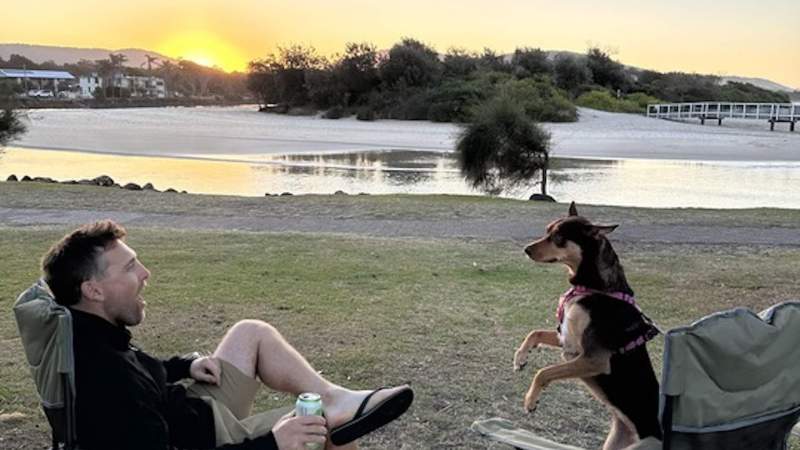Day Trips With Dogs Sydney – I’m going to go ahead and say that although I’ve had many dogs in my life, I’m primarily a cat person. However, I can feel the need for this book and indeed as part of doing this review, I spent some time surfing the web and found out that the guides around dogs are very light. Dog owners traveling with their dogs quickly learn that national parks, throughout Australia, are off limits to our four-legged friends (except assistance dogs) and that they struggle to find somewhere to walk their dogs.
This book is from authors Andrew Grune and Evi O who also produced Day Trip Sydney: 52 Nature Adventures which includes 52 walks for walkers within 120km of central Sydney. In terms of this book, there are 52 walks, all within 120 km of Sydney, but these walks are dog friendly. If you are a walker without a dog then the walking version is probably the best option but if you want to take your dog with you on some of your exercise, their second book is a good choice.
Day Trips With Dogs Sydney
This book is not the smallest or cheapest guidebook you will come across, but as these walks are under 10km many of them are very short, if you choose to stick with them they will don’t weigh your package. This simple and easy-to-follow layout is organized into ‘zones’:
Dog-friendly Travel (@travelnuity) • Instagram Photos And Videos
So depending on where you live or want to travel, you don’t need to search the book to find tours in your chosen area. In fact the travel section at the front of the page allows you to narrow down your choices before looking at detailed route descriptions. One thing that really stands out in the trip listing, as well as the distance and other key details, is that this section also indicates whether the trip is ‘on foot’ or ‘by foot’. usually recognized when you come out with an exit. that one. a dog
The information sections for each browser are simple and easy to read with nice little icons that make it easy to use the main features of each browser. The format of the book, the language used and the overall presentation are all designed to encourage people to get out and walk their dogs and clap with signs. Tours go from the city, to the beach, to the forest, to the waterfalls, so there is something for everyone from two to four meters.
This guide is well done and you are highly encouraged to go out and learn what a guide should do.
Disclosure: If you click on this link and make a purchase, we may earn a small commission, at no additional cost to you. Please note that our affiliations in no way affect the independence of our reviews. If we don’t like a product, you’ll hear from us!
Top Dog-friendly Places In Australia: Ultimate List
Sydney Dog Travel: Guide to 52 Dog Friendly Nature Adventures – has photos, maps and basic information on the first page.
Fact Sheet – Sydney dog tour. the second page with more pictures and some detailed information about the cultural tour.
Read on to discover three dog-friendly day trips from Dog Trip Sydney that are sure to inspire you to create unforgettable memories with your canine companion.

Often overlooked by Sydneysiders who don’t live in the eastern suburbs, Centennial Park is a living, breathing asset close to the CBD. The 189-hectare park, which acts as the city’s ‘green belt’, is home to an impressive array of native life (such as black swans, giant otters and corals) and flora (including figs, eucalypts, books and bank accounts) – as well as large plant species such as Evergreen oaks from the southern United States and Bismarck palms from Madagascar. As is characteristic of large parks established in the Victorian era, large areas of public gardens of lawns and meadows are surrounded by the perfect figs of Moreton Bay and surrounded by ponds, creating beautiful settings for sunbathing. In dog-friendly areas of the park, puppies can run away from each other.
40 Best Dog-friendly Days Out Around Sydney
The century was officially opened in 1888 by SirHenry Parkes – an English immigrant turned powerful politician and NSW leader – fulfilling his dream of creating a ‘people’s park’. Sir Henry has hired unemployed workers to help build the park, selling the land around the proposed site to pay their wages. However, not everyone shares Parkes’ optimistic view. In the 1960s, a statue of Charles Dickens was stolen from the park – forty years later, it was found headless (‘Please, sir, I want my head…’).
For mature bodies and minds, a visit to Ian Potter’s PLAY kindergarten is a must. The site is designed to encourage children to connect with nature by engaging in activities and education, and two-wheelers can hunt in tree houses and wade through waterfalls.
Seeing all the people and dogs enjoying this wonderful green space, the ghost of Sir Henry Parkes must have smiled (and, perhaps, enjoyed the irony of a man named after his family building a public park).
The Gleob Coast Path connects more than 27 hectares of public open space, the legacy of a four-year campaign for public access fought for and won by local residents and the Gleob Association, which was founded in 1969 to support Here the city water is mixed with its industrial estate, cranes and power plants with views of the main harbor and big trees.
Dog Friendly Day Trips » Visit Wollondilly
The district of Glib is in the country of Gadigal and Wangal of the people of Eora country. In 1789, the colonial government gave the land to the Anglican Church. Until the 1970s the area was an industrial area, dominated by timber yards, and workers’ cottages can be found between the large terraces of old Victorian and Federation houses. The boundary has been used for sports, with century-old sports equipment for cricket, football and rowing still in use today.
The walk begins as you enter Jubilee Park, with opportunities for informal activities in Federal Park, located to the south along Johnstons Creek. Adjacent to the Federal Park is the Bicentennial Park – still containing the original plantations of Canary Island palms and Moreton Bay fig trees, which tower over the historic cricket pavilion and garden. There is also a children’s playground.
Continuing north, it ends at the eastern end of Bicentennial Park before heading east along the shores of Rozelle Bay. Further east on the beach is the Pope Paul VI Sanctuary, with a divine view of Sydney’s trio of bridges: Anzac, Glebe Island and the Harbour. This deposit is to commemorate the first visit of the Pope in 1970 to Australia. Today the dogs are tied up in the ground, behaving without a trace of Catholic guilt.

The last stop is Blackwattle Bay Park, which completed its conversion from industrial to recreational use in 1983. With picnic and barbecue facilities, it is a great place to spend time. Dogs are also allowed to roam freely here. A landmark from the past is the heritage-listed Bellevue House, built in 1896 and designed by renowned architect Ambrose Thornley Jnr, who also designed the grand, Italianate Glebe town hall. Luckily, it’s a cafe full of sinful food temptations.
Sydney To Merimbula
Sydney Fish Market comes into view (or smells) as you approach Wentworth Park. Wander around the food festival – or head off the beaten path to Glebe Point Road for a taste of some bohemian style.
Between the lush valleys and lush vegetation of Cooper Park you’ll find a collection of natural wonders and layers of Native and European history. As you descend from the enormous steps into the huge crater created by the volcanic activity that began in the Jurassic period, it is hard to imagine how many times you have been in the jungle city before.
At the time of European colonization, and thousands of years ago, at least two families of the Eora nation – Gadigal and Birrabirragal – lived in this country, and their images and sacred places are scattered around the park (the exact terms depend on the situation. Aboriginal Community). In the early 1800s, former industrial and law baron Daniel Cooper began acquiring land in the area. In 1913, his relative, Sir William Cooper, agreed to a long-standing government request to give part of this land to the public, and it was designated as a park in 1917.
The park’s stone steps, bridge and amphitheater were built in the 1930s as part of a Depression relief plan. Unique rock-like grottoes dot the park, while kiosks, a playground and a tennis court provide food and entertainment for visitors.
Travel & Leisure
Walk through this 18-hectare urban green space, you will

